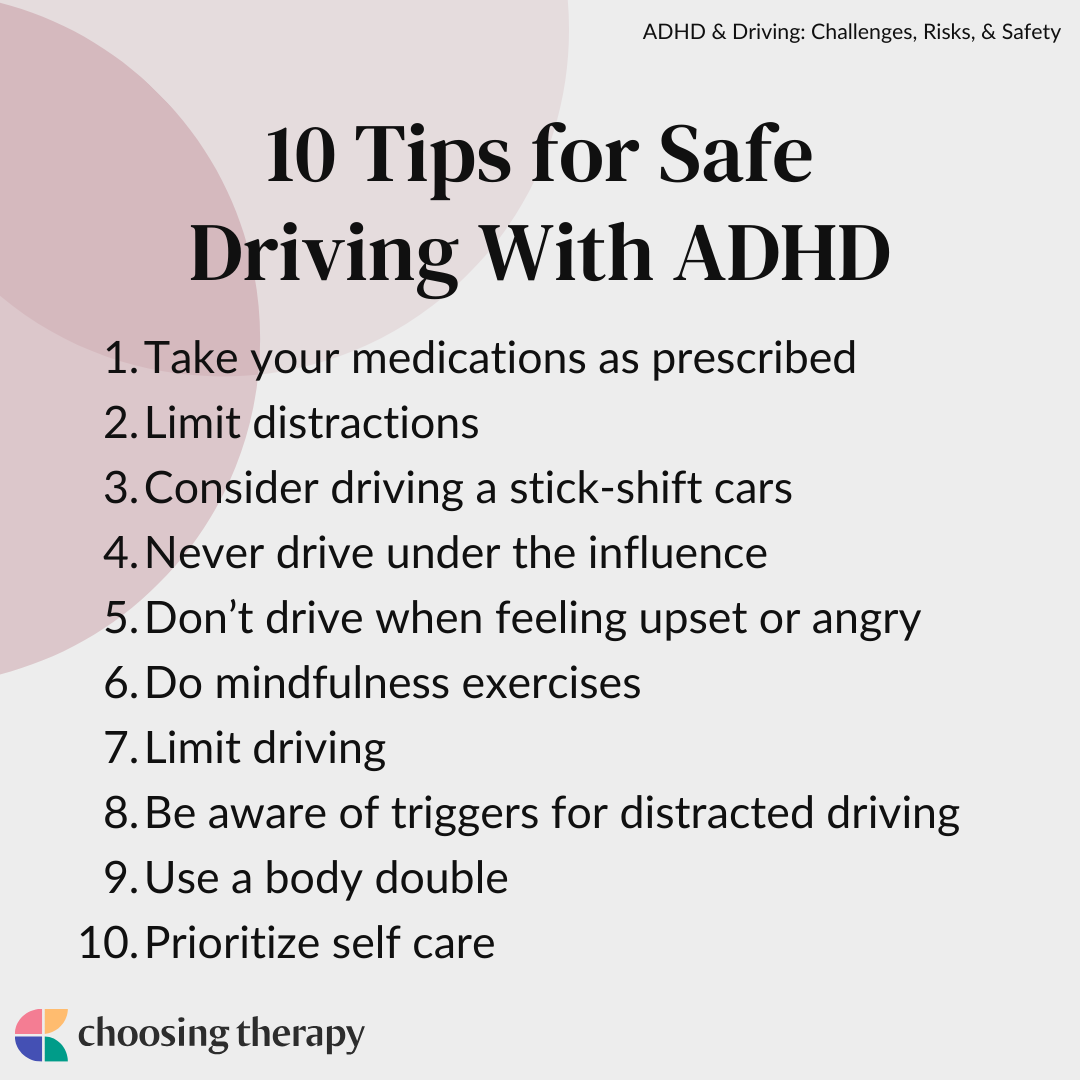ADHD And Driving Safety: Practical Applications Of Research Findings

Table of Contents
Understanding the Risks: ADHD and Impaired Driving
Increased Risk of Accidents:
Individuals with ADHD are statistically more likely to be involved in traffic accidents than neurotypical individuals. This increased risk is linked to several factors:
-
Impulsivity and risk-taking behaviors: Individuals with ADHD may engage in risky driving behaviors such as speeding, tailgating, or making sudden lane changes without adequately assessing the risks. This impulsive nature significantly increases the likelihood of accidents. Research consistently shows a correlation between higher impulsivity scores and increased accident rates in drivers with ADHD.
-
Difficulty maintaining attention and focus on the road: Sustained attention is paramount for safe driving. Individuals with ADHD may struggle to maintain consistent focus, leading to missed traffic signals, delayed reactions to hazards, and increased vulnerability to distractions. This inattention can result in near misses and collisions.
-
Problems with response inhibition leading to delayed reactions: Response inhibition—the ability to suppress inappropriate or impulsive actions—is often impaired in individuals with ADHD. This can lead to delayed braking or steering corrections, increasing the risk of accidents. Quick reaction times are vital for avoiding collisions.
-
Challenges with organizational skills impacting trip planning and route navigation: Poor organizational skills can lead to difficulties in planning routes, resulting in increased stress and potential for errors while driving. This can manifest as getting lost, missing turns, or making unplanned stops that compromise safety.
Specific Driving Challenges for Individuals with ADHD:
Beyond accident statistics, the everyday act of driving presents specific challenges for those with ADHD:
-
Difficulty following traffic rules and regulations: Individuals with ADHD may struggle to consistently adhere to traffic laws, leading to infractions such as speeding tickets or running red lights. This reflects difficulties with sustained attention to rules and regulations.
-
Issues with speed control and maintaining a safe following distance: Maintaining appropriate speed and following distance requires consistent attention and judgment. Individuals with ADHD may struggle to regulate speed, leading to unsafe following distances and increased risk of rear-end collisions.
-
Problems with multitasking, such as adjusting the radio or talking on a phone: Multitasking while driving is inherently dangerous, and individuals with ADHD may find it particularly challenging to focus on the road while performing other tasks. This can significantly impair reaction times and increase the risk of accidents.
-
Increased susceptibility to distractions, both internal and external: Internal distractions (racing thoughts, worries) and external distractions (other vehicles, pedestrians, billboards) can easily overwhelm individuals with ADHD, diverting attention from the primary task of driving safely.
-
Challenges with spatial awareness and judging distances: Accurate perception of spatial relationships is vital for safe driving maneuvers such as merging, parking, and overtaking. Difficulties in spatial awareness can lead to misjudgments and increased risk of collisions.
Neurobiological Factors and Driving Performance
Executive Function Deficits and Driving:
The core symptoms of ADHD, particularly inattentiveness and impulsivity, directly impact executive functions crucial for safe driving:
-
Working memory: Difficulty remembering instructions or directions while driving can lead to navigational errors and increased stress levels.
-
Inhibitory control: Trouble suppressing impulsive actions, like sudden braking or lane changes, is a major contributor to unsafe driving practices.
-
Cognitive flexibility: Struggling to adapt to changing traffic conditions (e.g., sudden stops, lane closures) can lead to delayed responses and increased accident risk.
The Role of Dopamine and Norepinephrine:
Neurotransmitter imbalances can influence attention, focus, and impulse control—all essential for safe driving:
-
Dopamine deficits: Can lead to decreased motivation and attention, making it harder to stay alert and focused on the road.
-
Norepinephrine imbalances: May affect alertness and response times, impacting the ability to react quickly to changing traffic conditions.
Strategies for Safer Driving with ADHD
Medication Management and its Impact on Driving:
Medication can significantly improve ADHD symptoms and enhance driving safety for some individuals. However, it’s crucial to consult with a physician:
-
Discussing medication side effects: Some medications may cause drowsiness or other side effects that could impair driving ability. Open communication with your doctor is crucial.
-
Finding the right dosage and type: Finding the optimal medication and dosage requires careful monitoring and adjustment.
-
Regular medical check-ups: Regular check-ups are essential to ensure the medication continues to be effective and safe.
Behavioral Strategies for Improved Driving Safety:
Beyond medication, behavioral strategies are key to safer driving with ADHD:
-
Mindful driving techniques: Practicing mindfulness can help increase focus and awareness while driving.
-
GPS navigation: Using GPS can minimize distractions associated with route planning and navigation.
-
Avoid driving when tired or stressed: Driving when fatigued or stressed significantly increases risk.
-
Plan routes in advance: Pre-planning routes reduces in-the-moment decision-making while driving.
-
Break long drives into shorter segments: This helps prevent fatigue and maintain focus.
Adaptive Driving Technologies:
Utilizing technology can create a safer driving experience:
-
Lane departure warning systems: Alert drivers if they drift out of their lane.
-
Adaptive cruise control: Maintains a safe following distance from the vehicle ahead.
-
Blind-spot monitoring: Detects vehicles in blind spots.
-
Forward collision warning systems: Alerts drivers to potential collisions.
Conclusion
Driving with ADHD presents unique challenges, but with proper understanding, management, and the application of research findings, individuals can significantly improve their driving safety. By addressing the neurobiological underpinnings of ADHD and implementing effective strategies—including medication management, behavioral techniques, and leveraging adaptive driving technologies—individuals with ADHD can mitigate risks and become safer drivers. Remember, seeking professional guidance from healthcare providers and driving instructors is crucial for developing personalized strategies to enhance your driving safety and manage your ADHD. Don’t hesitate to discuss your concerns and explore options for safer driving with ADHD.

Featured Posts
-
 Suspecting Adult Adhd Your Guide To Next Steps
Apr 29, 2025
Suspecting Adult Adhd Your Guide To Next Steps
Apr 29, 2025 -
 Las Vegas Police Seek Publics Help In Finding Missing Paralympian Sam Ruddock
Apr 29, 2025
Las Vegas Police Seek Publics Help In Finding Missing Paralympian Sam Ruddock
Apr 29, 2025 -
 Untapped Potential Group Support For Improved Adhd Outcomes
Apr 29, 2025
Untapped Potential Group Support For Improved Adhd Outcomes
Apr 29, 2025 -
 Porsche Pardavimai Lietuvoje 2024 M 33
Apr 29, 2025
Porsche Pardavimai Lietuvoje 2024 M 33
Apr 29, 2025 -
 Trumps Reaction To Mlbs Pete Rose Decision A Posthumous Pardon
Apr 29, 2025
Trumps Reaction To Mlbs Pete Rose Decision A Posthumous Pardon
Apr 29, 2025
